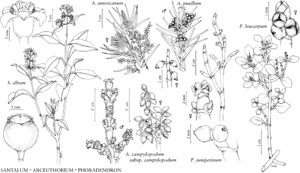Phoradendron leucarpum
Taxon 38: 107. 1989.
Subshrubs, erect, 4–10 dm, dioecious. Stems green, grayish green, or yellowish green, hairy, hairs simple or stellate, white or yellow, becoming glabrate; internodes terete, 8–59 × 1–3 mm. Leaves bright green, yellowish green, or grayish green, well developed, hairy, hairs simple or stellate; petiole 3–8 mm; blade obovate, spatulate, ovate, ovate-elliptic, or nearly orbiculate, 14–48 × 8–30 mm, thin to thick and rigid, base cuneate to obtuse, apex rounded; basal phyllotaxy transverse. Staminate inflorescences 10–80 mm, hairy, hairs simple or stellate; peduncle with 1 internodes, 2–4 mm; fertile internodes 2–7, each (15–) 29–39 (–62) -flowered, triseriate, becoming irregular, flowers 1–10 per column. Pistillate inflorescences 10–80 mm, hairy, hairs simple or stellate; peduncle with 1 internode, 2–4 mm; fertile internodes 2–6, each (4–) 6–11 (–20) -flowered, triseriate, flowers 1–3 per column. Flowers: petals 3, 1 mm. Berries white, oblong to globose, 3–6 × 2–5 mm, glabrous.
Phenology: Flowering Oct–Mar.
Habitat: Hardwood forests and woodlands.
Elevation: 0–1800 m.
Distribution

Ala., Ariz., Ark., Calif., Del., D.C., Fla., Ga., Ill., Ind., Kans., Ky., La., Md., Miss., Mo., N.J., N.Mex., N.Y., N.C., Ohio, Okla., Oreg., Pa., S.C., Tenn., Tex., Va., W.Va., Mexico (Chihuahua), Mexico (Coahuila), Mexico (Durango), Mexico (Nuevo León), Mexico (San Luis Potosí), Mexico (Sonora), Mexico (Tamaulipas)
Discussion
J. Kuijt (2003) used the name Phoradendron serotinum, based on the name Viscum serotinum Rafinesque (1820), not P. leucarpum, which is based on the earlier name by the same author, V. leucarpum (1817). A proposal to conserve the later name (D. L. Nickrent et al. 2010b) was not accepted, thus the name P. leucarpum has priority.
Phoradendron leucarpum has a convoluted taxonomic history, reflecting not only various species concepts but also complex evolutionary and ecological processes. Among the 234 species of Phoradendron, J. Kuijt (2003) recognized subspecies only in P. leucarpum (as P. serotinum). In addition to the typical subspecies from eastern Texas eastward, they are subsp. augustifolium from Mexico, subsp. macrophyllum from eastern Texas through New Mexico and Arizona to California and Oregon, and subsp. tomentosum, with about the same distribution as subsp. macrophyllum but also extending into Mexico. Kuijt noted that in some geographic areas, such as east-central Texas, the putative subspecies show a continuum of morphological intergradation.
A population genetic and morphometric study of this complex was undertaken by A. K. Hawkins (2010). Principal component analyses using the characters that J. Kuijt (2003) considered to be diagnostic of the subspecies, such as leaf size, color, and venation, as well as the type and density of hairs present on young vegetative and reproductive tissues, in addition to host species, did not result in clusters corresponding to the four described subspecies. Moreover, FST analyses of microsatellites showed significant interpopulational differentiation that did not match the subspecies that Kuijt recognized. Because morphological and molecular analyses show that subspecies, at least as defined by Kuijt, cannot be differentiated in Phoradendron leucarpum, no subspecies are accepted here.
Phoradendron leucarpum is the only species of the genus found east of Texas. It parasitizes over 60 species of native and introduced trees, especially Acer, Fraxinus, Juglans, Nyssa, Platanus, Populus, Quercus, Salix, and Ulmus.
Lower Taxa
"thin" is not a number.
